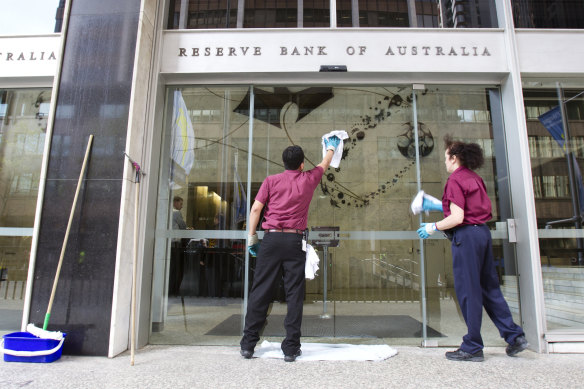Chance of rate rise for Melbourne Cup Day increases as inflation rises
By Shane Wright and Rachel Clun
A larger-than-expected rise in prices on everything from petrol to property rates could force the Reserve Bank to lift official interest rates next month to a 12-year high, but Treasurer Jim Chalmers maintains inflation is on track to return to normal levels as government programs ease key pressure points.
Inflation – both headline and underlying– increased in the September quarter by 1.2 per cent, the Australian Bureau of Statistics reported. At the annual rate, inflation eased from 6 per cent to 5.4 per cent.

Soaring petrol prices have contributed to a higher-than-expected inflation result.Credit: Louie Douvis
Almost three-quarters of all goods and services tracked by the bureau recorded price increases of more than 2 per cent over the past year, with one-fifth growing by more than 8 per cent.
Some economists say these inflation figures mean a Melbourne Cup Day rate rise is increasingly likely following Reserve Bank governor Michele Bullock’s warning the bank board would not hesitate to raise interest rates if needed.
Other experts argued further rate rises would have little impact on some of the key drivers of price rises, while the ABS said inflation would have been higher without key government cost-of-living interventions which dampened price rises for some essentials such as power prices.
Treasurer Jim Chalmers said while the government would like inflation to be lower, it was clear their policies were helping to get it down.
He argued that while inflation had risen in the quarter, it was still tracking the Treasury’s own forecasts to slip within the Reserve Bank’s 2-3 per cent target band by early 2025.
“It’s really important to recognise that the annual inflation number that we have received today is in line with expectations, it’s in line with the Treasury forecasts in the most recent budget, and it doesn’t change the Treasury’s expectations for when inflation will return to the target band,” he said.
Over the past year, rents have climbed by 7.6 per cent, which is the largest annual increase since 2009, but the ABS said it would have been higher without the increase in Commonwealth Rent Assistance that came into effect on September 20.
Childcare costs fell by 13.2 per cent in the September quarter due to changes to the childcare subsidy introduced by the federal government in June. The ABS said without the change, childcare costs would have climbed by 6.7 per cent.
Electricity prices, which rose by 4.2 per cent in the quarter, were also partially offset by the federal government’s energy bill relief – electricity prices would have risen by 18.6 per cent in the September quarter without it.
But some economists said the data supported the case for another interest rate hike, with both goods and services inflation uncomfortably high.
Economists at both the Commonwealth Bank and ANZ, which had been expecting the RBA to hold rates steady next month, expect it to increase the cash rate by a quarter percentage point to 4.35 per cent.
Such an increase would add $101 to the monthly repayments on a $600,000 mortgage. That would be on top of the cumulative $1400 increase in monthly repayments since the bank started tightening monetary policy in May last year.
EY chief economist Cherelle Murphy said inflation was now out of line with the Reserve Bank’s most recent forecasts, which have inflation easing to 4.1 per cent by the end of the year.
“For goods, inflation had been falling for five successive quarters, but it has now picked up again. Similarly for services, after two successive quarters of moderating inflation, it rose again in the September quarter,” she said.
“Today’s data and recent events mean the Reserve Bank’s job isn’t done yet.”
Over the past 12 months, insurance costs jumped by 14.7 per cent, the largest increase since 2001, and dental service inflation has also continued to pick up, reaching 4.9 per cent.
Asia-Pacific economist at job site Indeed, Callam Pickering, said the RBA’s inflation forecasts appeared to be “increasingly optimistic”, which meant a rate rise next month was possible.
“If the RBA has to revise their inflation forecast upward, from an already high level, then there is a clear justification to hike rates,” he said.
On Tuesday evening, the RBA governor said the bank board “would not hesitate” to raise the cash rate if there was a material increase in inflation, but the bank board was also mindful that household spending was easing and there were long delays in the impact of rate rises.
CreditorWatch chief economist, Anneke Thompson said the RBA board would be asking what a higher cash rate could actually do to slow those price rises.
“In some key categories, such as rents, utilities, insurance and fuel, a cash rate increase will have little to no impact on any future pricing,” she said. “This will be taken into careful consideration by the central bank.”
Deloitte Access Economics partner Stephen Smith said the figures do not support the case for another rate rise, given none of the strong price growth seems to be driven by household spending.
“Combined with the fact that the full impact of earlier rate rises is still to be felt, there remains little justification to increase interest rates in Australia beyond their current level of 4.1 per cent,” he said.
Cut through the noise of federal politics with news, views and expert analysis. Subscribers can sign up to our weekly Inside Politics newsletter.